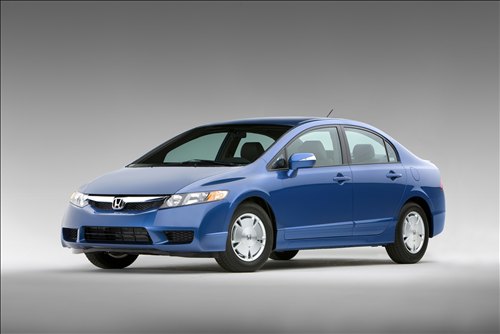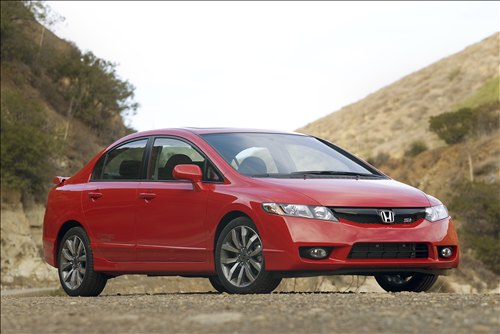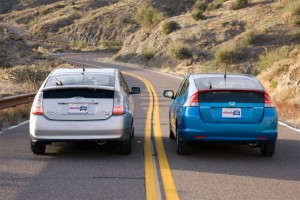Honda Civic Type R
Honda Civic Type R
General specifications
Country of origin Japan
Numbers built N/A
Introduced 2006
Introduced at 2006 Paris Motor Show
Engine
Configuration Straight 4
Location Front, transversely mounted
Displacement 1.998 liter / 121.9 cu in
Bore / Stroke 86.0 mm (3.4 in) / 86.0 mm (3.4 in)
Compression 11.0:1
Valvetrain 4 valves / cylinder, DOHC, w/ VTEC
Fuel feed Fuel Injection
Aspiration Naturally Aspirated
Drivetrain
Chassis/body unitary steel
Gearbox 6 speed Manual
Drive Front wheel drive
Performance figures
Power 201 bhp / 150 KW @ 8000 rpm
BHP/Liter 101 bhp / liter
0-60 mph 6.4 s
The hotly-anticipated Honda Civic Type R goes on sale in March 2007, and it's been well worth the wait. While it's just as exhilarating to drive as the outgoing Type R, the latest high performance Civic is a more refined 'superhatch', with improved comfort levels, integrated styling and handling tuned for enhanced responsiveness and predictability. The new Type R continues to be powered by the naturally-aspirated, high-revving 2.0-litre DOHC i-VTEC engine but the unit has been significantly reworked to improve responsiveness using a new balancer shaft and drive-by-wire throttle control. VTEC variable valve timing and VTC variable inlet camshaft technology continue to underpin the engine structure. Further development of the Type R unit means more useable torque, as the switch to high-lift, long duration valve timing (the cam change) now takes place at a lower 5,200rpm, and continues all the way to 8,000rpm. So that screaming, high rpm VTEC range is broader and more accessible. To mark the entry to this 'power band' a new i-VTEC indicator just to the right of the digital speedometer is illuminated once the revs rise above 5,200rpm. Maximum power is now 201PS, reached at 8,000rpm (previously 200PS at 7,400rpm) and the car is more responsive generally, while improved aerodynamics ensure the new car cuts through the air more cleanly. Slightly lower gearing compensates for a small increase in kerb weight. Acceleration figures are expected to be virtually identical to the 6.6-second 0-62mph time of the outgoing car - and the new car should match its top speed too, powering on to 146mph.
The chassis of the Civic 5-door - already widely praised for its handling balance - forms the basis for all 3-door models and provides an ideal platform for the Type R. Building on the Civic Type S suspension, which is fine-tuned for sharper chassis dynamics, the Type R takes those modifications to the next level. Like the Type S, its rear track is 20mm wider than that of the 5-door model, but otherwise damper, bush and spring characteristics are all unique to Type R. Broad 225/40 ZR18 tyres provide added grip, while a 15mm reduction in ride height further reduces body roll. Firmer steering, a quicker ratio and stiffer steering box mountings all provide pin-sharp responses to steering wheel input, while the fuel tank's central location beneath the cabin floor helps to lower the centre of gravity and reduces the body's inertia moment. The Type R also builds on the Civic's body structure - one of the stiffest in the C-sector - and that rigidity plays a key role in the responsive chassis dynamics. Extra strengthening has been introduced into the floor cross member just ahead of the central fuel tank, around the upper front suspension mountings, while the lower cross member (just ahead of the engine bay) provides greater rigidity. The overall result is a more predictable chassis, with levels of responsiveness and stability that are some of the best in class. At the same time, the damper settings deliver enhanced ride comfort, so the Type R is easier to use in all conditions and on all surfaces.
While the styling of previous Civic Type Rs has almost been an after-thought, the latest car enhances the already-bold appearance of the Civic to build an incredibly assertive look. Seven-spoke 18-inch alloy wheels are fitted as standard and - helped by the car's low ride height - these tuck neatly under the body coloured arches. The deep front spoiler incorporates a larger air intake to channel air to the induction system, as well as triangular foglamps. There's no missing the distinct body-coloured tailgate rear spoiler, which follows the kick-up line from the rear quarter windows, and provides added down-force. At the front, a black honeycomb mesh grille replaces the glass panel of other Civics, sporting - of course - the infamous red 'H' badge. While more discreet than on the outgoing car, Type R logos feature throughout. Firstly, the front brake callipers wear the insignia, and stainless steel inserts on the door sills also carry the badge.
Inside, it's all about the driving experience














